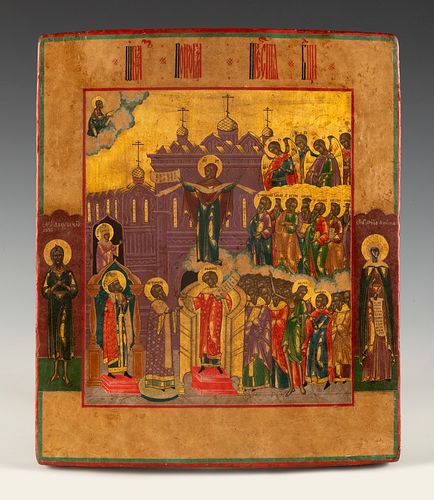Russian school, probably Moscow or northern schools, second half of the 19th century. "The Protection of the Mother of God", or "The Virgin of Pokrov
Lot 96
About Seller
Setdart Auction House
Carrer Aragó 346
Barcelona
Spain
Setdart Subastas was born in 2004 and is currently the first online art auction in Spain with solidity, prestige and reliability guaranteed by our more than 60,000 users. Setdart has a young, dynamic and enterprising team ready to successfully manage the purchase and sale of art works through custom...Read more
Estimate:
EUR€1,500 - EUR€1,800
$1,630.43 - $1,956.52
Absentee vs Live bid
Two ways to bid:
- Leave a max absentee bid and the platform will bid on your behalf up to your maximum bid during the live auction.
- Bid live during the auction and your bids will be submitted real-time to the auctioneer.
Bid Increments
| Price | Bid Increment |
|---|---|
| EUR€0 | EUR€10 |
| EUR€200 | EUR€25 |
| EUR€500 | EUR€50 |
| EUR€1,000 | EUR€100 |
| EUR€3,000 | EUR€200 |
| EUR€5,000 | EUR€500 |
| EUR€10,000 | EUR€1,000 |
| EUR€20,000 | EUR€2,000 |
| EUR€50,000 | EUR€5,000 |
About Auction
By Setdart Auction House
Nov 3, 2021
Set Reminder
2021-11-03 08:00:00
2021-11-03 08:00:00
America/New_York
Bidsquare
Bidsquare : OLD MASTERS
https://www.bidsquare.com/auctions/setdart-auction-house/old-masters-7786
Setdart Auction House sofia@setdart.com
Setdart Auction House sofia@setdart.com
- Lot Description
Russian school, probably Moscow or northern schools, second half of the 19th century. "The Protection of the Mother of God", or "The Virgin of Pokrov". Tempera, gold leaf on boards. Measurements: 35 x 30 cm. "The Virgin of Pokrov" is one of the iconographies of the Russian Orthodox Church, although it describes events that happened in Constantinople around the year 910. A priori the story was taken from the biography of Andrew of Constantinople, who together with his disciple Epiphanius, saw the Mother of God flying over the Church of St. Mary of the Blanquernas, covering the believers with her omophorion, as a symbol of protection. On several occasions the story was modified, the last being the version of Bishop Demetrius of Rostov, composed towards the end of the XVII century, and which said that among those who saw the miracle were John the Baptist, John the Apostle, Andrew of Constantinople, and King Leo the Wise. The significance of this miracle is that the Mother of God protected the city of Constantinople against the Muslim invasion. The prototype of the icon of the protection of the Mother of God, or, in Russian, of Pokrov, develops around the 14th century, although it will have more impact in the following centuries. There are two main typologies of the representation of this scene. One, the oldest, belongs to the Novgorod school. The other, the one we have in front of us, was developed in the Rostov and Suzdal school, and was finally implemented in the Moscow school. The latter typology is distinguished by the Mother of God depicted in the central register, in front of the church. The omophorion, or the "pokrov", with which she protects the believers, she holds in her two hands, instead of being held by the two angels, as would be depicted by the Novgorod painters. Apart from the apostles, different martyrs, and Andrew of Constantinople, in the lower central register, just below the Virgin, there is a character typical of the Rostov school, Roman the Méloda, the author of several songs dedicated to the Virgin Mary. It is worth noting that on both sides of the scene we see St. Alexius of Rome, or St. Alexius the Beggar, and the martyr Anisia of Thessalonica. The characteristics of the auctioned lot are very peculiar, and help to determine the approximate date and even the school with great accuracy. The central figure of the Virgin appears with her face slightly turned to the left, while in the traditional version it is usually frontal. Together with the very ornamental typography, and the painted clouds, imitating archaic stylistics, it can be concluded that it is an icon painted in the workshops of the northern schools, or rather in the Muscovite workshops, both styles with many points in common. Most probably it is about the so-called "fedoseevtsy" painters, who were the Old Believers from the North of Russia, who settled in Moscow, in the Preoobrazhenskoe cemetery, around 1771, and organized an icon-painting workshop there.
- Shipping Info
-
In-house shipping available. Please inquire at admin@setdart.com.
-
- Buyer's Premium



 EUR
EUR CAD
CAD AUD
AUD GBP
GBP MXN
MXN HKD
HKD CNY
CNY MYR
MYR SEK
SEK SGD
SGD CHF
CHF THB
THB

















